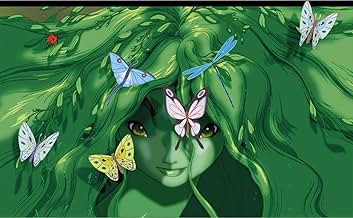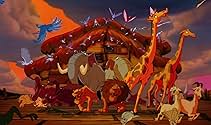Aggiornamento del film originale con nuove interpretazioni di grandi opere di musica classica.Aggiornamento del film originale con nuove interpretazioni di grandi opere di musica classica.Aggiornamento del film originale con nuove interpretazioni di grandi opere di musica classica.
- Premi
- 4 vittorie e 7 candidature totali
- Themselves
- (as The Chicago Symphony Orchestra)
- Self - Featured Soprano (segment "Pomp and Circumstance")
- (voce (canto))
- (non citato nei titoli originali)
- Self - Animator
- (non citato nei titoli originali)
- Self - Animator
- (non citato nei titoli originali)
- Self - Pianist (segment "Piano Concerto No. 2, Allegro, Opus 102")
- (non citato nei titoli originali)
Trama
Lo sapevi?
- QuizThe Broadway ending sequence of "Rhapsody in Blue" contained so many different colors (over 200) that the CAPS system had trouble rendering it, causing delays in the production of Tarzan (1999).
- BlooperIn "Rhapsody in Blue", a sign inside Monica's cafe reads "2 EGGS ANY STYLE 25c". A sign outside the cafe reads "2 EGGS 10c".
- Citazioni
James Earl Jones: [introducing the Carnival of the Animals] These drawing boards have been the birthplace of some of the most beloved animal characters of all time. So it's no surprise that they choose for our next segment, "The Carnival of the Animals" by Camille Saint-Saëns. Here the sensitive strains of impressionistic music combine with the subtle artistry of the animator to finally answer that age old question: "What is man's relationship to nature?"
[is handed a piece of paper]
James Earl Jones: Oh, sorry... That age old question: "What would happen if you gave a yo-yo to a flock of flamingos?"
[turns to look off-camera]
James Earl Jones: Who wrote this?
- Curiosità sui creditiRight after the final credits, you hear Steve Martin's voice, wondering out loud if he's still on camera, then realizes it's the end of the movie. He then asks the audience, 'Can I have a ride home?'
- Versioni alternativeThe Rat Scene from Piano Concerto No.2
- ConnessioniEdited from Fantasia (1940)
- Colonne sonoreSymphony No. 5
Written by Ludwig van Beethoven
Performed by James Levine and the Chicago Symphony Orchestra
1. "Symphony #5" - the battle between good and evil with colorful abstract triangles, unmistakably based on butterflies, being attacked by black triangles in an ethereal setting. this segment did not impress me at all when i originally saw the film, but seeing it again, i am able to appreciate the pastel artistry (the DVD provides a lot of insight on to how difficult it was to create this segment). the segment as a whole may be one of the weakest, but it is very beautiful. possibly the greatness and familiarity of the music diminishes the segment's overall power. it is possibly the single most famous piece of music ever written. 8/10
2. "Pines of Rome" - a family of whales fly around in the air. i actually disliked this segment when i first saw the film last january. personally, computer animation used in an animated film always made me cringe. watching it again, i now love the way the cgi whales move and look against the cell animated backgrounds. now i feel that this is maybe the best segment of the film. the music is the best of all. i had never heard it before. the story is also probably the best of them all. it turns out to be one of the most beautiful and miraculous pieces of animation ever created. 10/10
3. "Rhapsody in Blue" - several stories of unhappy people are told and intersect in New York City. First off, this is a great piece of music and one of the most unique pieces of animation i have seen. Disney here forgot its attempts at realism and just went for charicatures. it is incredible to see animators create a microcosm of a Robert Altman film as a silent film. This was one of my favorites the first time i saw the film, and it remains so now. 10/10
4. "Piano Concerto #2, Allegro, Opus 102" (The Steadfast Tin Soldier) - again, when i first saw the film, I was annoyed at their use of computer animation. now, i see how wonderful this segment really is and how the computer animation works within the beautiful cell animation. the characters in this segment are beautifully made. the tin soldier himself isn't all that impressive, but the ballerina and the jack-in-the-box are amazing creations, among the most effective characters disney has ever created. I love the music in this one, too. i had never heard it before. the only thing i can fault this film for is that the animators changed the ending from a sad or bittersweet ending to a happy one. they claim that the music made them change it, because the music was more upbeat when it ended. this is true, but i also think that they would never have been allowed to end it sadly even if the music had ended so. Disney does not want to depress anyone, and they would slap a happy ending on it no matter what. but, with the music as an excuse, i can accept the ending of the film. 10/10
5. "Carnival of the Animals, Finale" - my least favorite segment, when i first saw it and now. it is only about 3 minutes long, and i'm glad for that. i do like it a bit more now, the art, watercolor, anyway. the story is very formulaic, and it follows the annoying tradition of silly disney animal characters like Timon and Pumbaa and Sebastion the crab and so many others. The segment is merely okay, and its shortness provides those children who are bored (the movie wasn't made for them in the first place) to be entertained a little more. 7/10
6. "The Sorcerer's Apprentice" - Who can argue? it is a classic. maybe it shows a little laziness in the filmmakers, to just slap this onto a 65 minute film to pad it to 70 minutes, but who cares. it is wonderful. If you get the DVD, make sure to listen to Mickey Mouse's commetary about this segment. it is awesome. 10/10
7. "Pomp and Circumstance" - this may be the most famous of the pieces of music, only competing with Symphony #5, because of its association with graduation. It works surprisingly well with the story of Donald as Noah's assistant who can never find his wife Daisy on the arc and thinks she was left out. Even though they don't acknowledge it anywhere on the DVD, this is obviously based on Buster Keaton's The Naviagator, a silent comedy. This segment ends up being very funny, almost as good as The Sorcerer's Apprentice, and even touching. It is very worthy, even though i know most people blew it off. 10/10
8. "Firebird Suite - 1919" - probably the best of the bunch, and the best film to end on. the order of the segments is actually quite well planned out, spacing them out interspersing beauty and whimsy quite well so as to never cross over emotions between two segments. each starts afresh. The Firebird Suite is the story of death and rebirth in nature, with a sprite helping nature to bloom after the winter. she awakes the firebird, a volcano, which destroys all that she has created. at the end, after being destroyed, a majestic elk revives the sprite and she revives nature. the only fault i could think of, and it does harm the film for a few people, is the tremendous similarities between it and Mononoke Hime, Princess Mononoke, which disney distributed last year. I have heard this segment called a rip-off of that film, but, with the tremendously long amount of time it takes to produce an animated piece, i will guarantee that The Firebird Suite was in developement over a year before Mononoke was released. Death and rebirth is such a common theme, it is universal. It is done as well here as it is in Mononoke Hime. 10/10
The interstitials - this is surely the worst part of the film, and it completely diminishes the film's value. We do not need famous people telling us that it is okay to listen to classical music. This is an insult to our intelligence. buy the DVD, and fast-forward over these chapters. 5/10.
Overall, 9/10, one of the best films of 2000, one of the most miraculous animated films ever made. It was not well received by critics or audiences, and i think this was a huge mistake. remember, the first fantasia bombed, too. maybe someday in the future, when the minds of Americans become more intelligent and complex again, Fantasia 2000 will get its due.
I più visti
Dettagli
- Data di uscita
- Paese di origine
- Sito ufficiale
- Lingua
- Celebre anche come
- Fantasia/2000
- Luoghi delle riprese
- Aziende produttrici
- Vedi altri crediti dell’azienda su IMDbPro
Botteghino
- Budget
- 80.000.000 USD (previsto)
- Lordo Stati Uniti e Canada
- 60.655.420 USD
- Fine settimana di apertura Stati Uniti e Canada
- 2.290.525 USD
- 2 gen 2000
- Lordo in tutto il mondo
- 90.874.570 USD
- Tempo di esecuzione1 ora 15 minuti
- Colore
- Mix di suoni

























